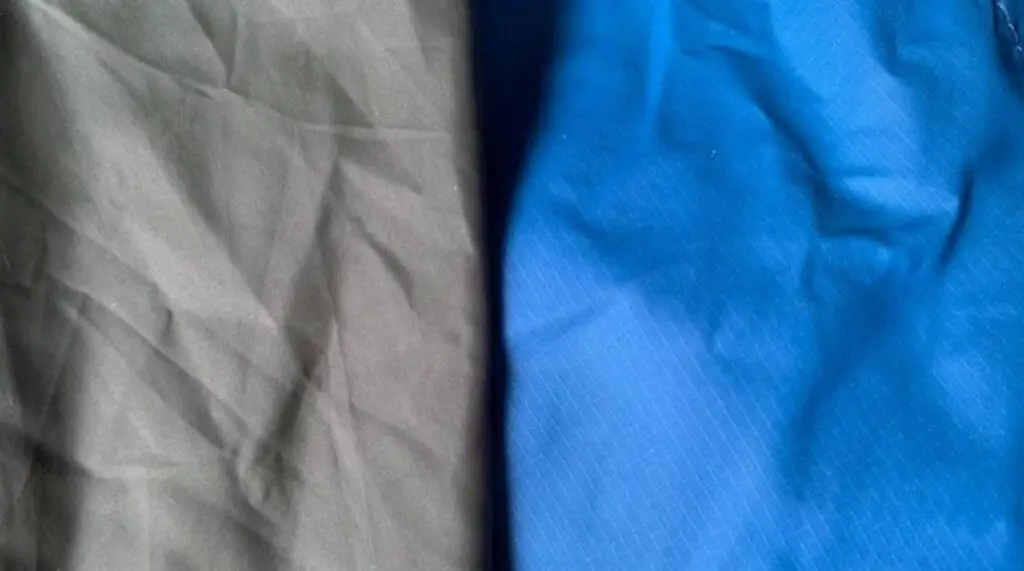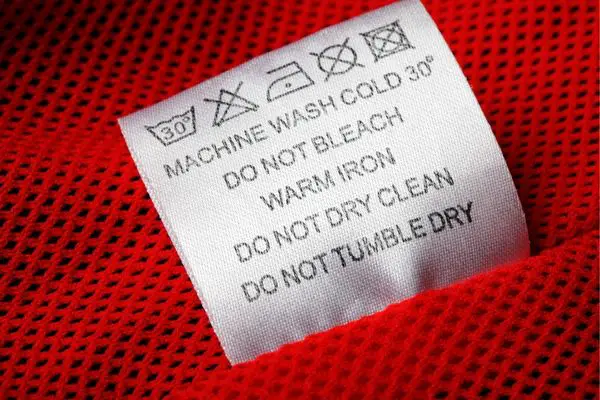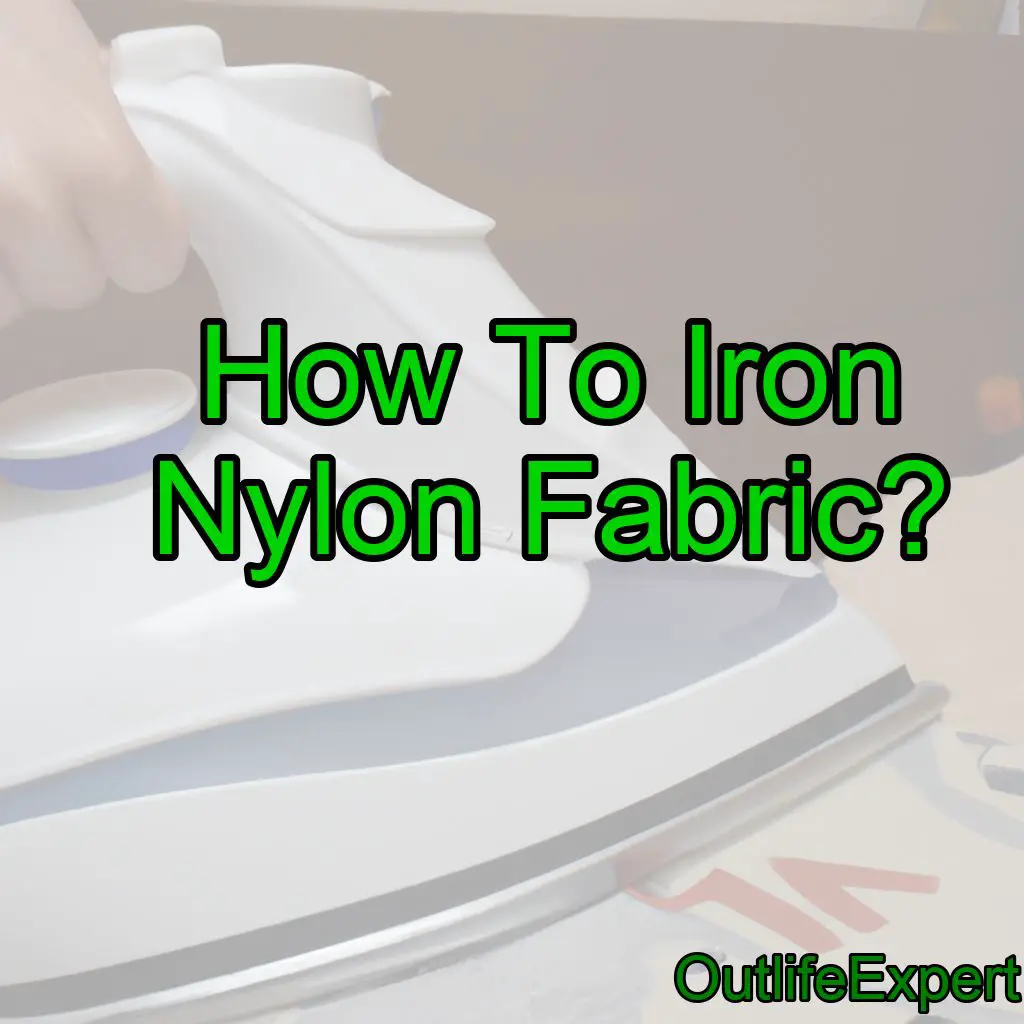Ironing nylon fabric can be tricky, but it doesn’t have to be. With the right approach and a few simple steps, you can easily iron your favorite piece of clothing with confidence.
To iron nylon fabric, follow these steps:
1. Check the care label: Before ironing, always check the garment’s care label for specific instructions or warnings.
2. Set up the ironing board and iron: Place the ironing board in a well-lit area and plug in the iron. Set the iron to the lowest heat setting or the setting specifically designed for nylon, usually indicated by a symbol of one dot.
3. Test a small area: Before ironing the entire garment, test a small, inconspicuous area to ensure the heat setting is appropriate and won’t damage the fabric.
4. Use a pressing cloth: Place a thin, clean cloth (such as a cotton pillowcase or dish towel) over the nylon fabric to protect it from direct contact with the iron. This will help prevent scorching or melting.
5. Iron gently: With the pressing cloth in place, gently glide the iron over the fabric, avoiding excessive pressure or tugging. Keep the iron moving to prevent damage to the fabric.
6. Hang or lay flat to dry: After ironing, hang the garment or lay it flat to dry completely. Avoid folding or stacking the garment while it’s still warm, as this can cause creases to form.
Remember to always use caution when ironing delicate fabrics like nylon, and adjust your technique as needed based on the specific garment and its care instructions.
The great thing is that once you know what temperature setting works best for different types of nylon fabric, you’ll always feel free knowing that you’ll look good no matter where life takes you.
So let’s take a closer look at how to achieve perfectly pressed pieces of apparel each and every time!
Pre-Treating Nylon Fabric
When it comes to ironing nylon fabric, preparation of the fabric is a must if you want the best results.

First and foremost, make sure to lay down flat any seams or frays before laying out your fabric for pressing.
You’ll also need several press cloths on hand to protect your material from direct heat.
If you’re unsure of what type of fabrics are suitable as protective layers, reach out to an outdoor expert who can provide guidance.
Once all the prep work is done, adjust the temperature settings according to the weight of your fabric; heavier weights require higher temperatures while lighter weights will do well with lower ones.
Be sure to have good temperature control when getting ready to start ironing!
Ironing Nylon the right way
Ironing nylon is the key to a crisp and professional look. Crafting this precise outcome requires an attention to detail, making sure you know each step of the process before beginning.
With that in mind, let’s take a closer look at how to properly iron nylon fabric.
Using the right temperature setting on your iron is essential when working with nylon; too low and you won’t get enough heat for it to set, but too high can damage or discolor the fabric. To avoid any potential issues, make sure your iron doesn’t exceed medium heat while pressing down on the garment.
Additionally, if using steam techniques, use a pressing cloth between the item and board so as not to saturate the material with moisture.
When done correctly, this will help give your piece its desired shape without compromising quality.
Heat shields are also recommended when steaming or pressing items made from delicate materials such as nylon – these act as protective layers which allow you to press directly onto them instead of risking scorching fabrics beneath them.
With all these tips in mind, creating beautiful pieces out of nylon fabric no longer needs to be intimidating! By following our guidelines above, you can achieve excellent results every time – giving garments a sharp finish that makes them look their best.
Using Steam instead
Ironing nylon fabric can be tricky, but with the right technique and equipment, you can have your garments looking their best in no time.
To begin, make sure to use a steam setting on your iron as well as a pressing cloth between the garment and the hot plate of the iron.
The heat setting should be appropriate for the particular type of nylon being used; if unsure, consult the label or manufacturer’s instructions about temperature control before proceeding.

When steaming, only lightly mist water droplets over the surface of your garment – avoid drenching it! As you press down with the iron, move quickly across the fabric while keeping an eye out for any signs of damage or discoloration.
If this occurs, turn down the heat immediately to avoid burning or melting your item.
Avoiding Damage
If you’re looking to iron nylon fabric without damaging it, then there are a few key tips and tricks you should know.
First off, checking the temperature of your iron is essential. You want to make sure that the heat setting isn’t too high for whatever type of nylon fabric you’re working with; otherwise, it can be damaged easily!
Once you’ve adjusted the setting accordingly, remember to keep an eye on your ironing board – if it’s getting too hot while in use, this could lead to further damage as well.
For added protection when ironing nylon fabric, consider protective steaming. This method helps relax fibers before pressing them down with an iron, allowing for smooth results each time!
It also prevents any unnecessary creases from forming during or after the process. Be sure to follow all instructions carefully when using steam-based products though – improper usage may cause more harm than good.
Lastly, don’t forget about proper technique when tackling tough wrinkles or folds in your material.
Take extra care around buttons and seams by gently hovering over those areas rather than pressing down hard with your iron.
With patience and some practice, you’ll soon have perfectly pressed garments made out of nylon fabric every single time!
Frequently Asked Questions
What Is The Best Temperature To Set The Iron At When Ironing Nylon Fabric?
When it comes to steam ironing nylon fabric, you have to be careful with the heat settings. According to a recent survey, nearly 85% of people don’t know the correct temperature for their garment or fabric type when using an iron.
The best temperature setting for ironing nylon fabric is usually around 185°F (85°C). To ensure that your results are smooth and wrinkle-free, use a pressing board and cover it with a pressing cloth first before applying heat.
If needed, you can also apply some fabric glue along the seams prior to ironing. With this expert advice in mind, now you’ll be able to get perfect, crease-free nylon garments every time!
Can I Use A Spray Bottle Of Water To Dampen My Nylon Fabric Before Ironing?
When it comes to steam pressing your nylon fabric, the best way to get a crisp finish is with an iron.
But if you don’t have one handy, using a spray bottle of water can be just as effective!
Spray the fabric lightly and let it air dry before proceeding with your heat setting.
To ensure that your finished product has a smooth texture, add in some fabric softener or starch substitutes.
And don’t forget to use a pressing cloth if needed – it will help protect the surface beneath from being scorched by the heat of the iron.
With all these tips, you’ll have perfectly pressed nylon fabric in no time!
What Is The Best Way To Remove Wrinkles From Nylon Fabric Without Using An Iron?
Ah, the age old question of how to remove wrinkles from nylon fabric without using an iron. While this may seem like a tall order for some, there are actually plenty of pre-washing tips and steaming methods that any outdoor enthusiast can use!
From using towels to pressing boards, these nifty tricks will help you get those pesky wrinkles out of your fabrics in no time. And if all else fails, adjust your heat settings as needed – just remember that too much heat could potentially damage the fabric itself.
In short, getting wrinkle free nylon is totally doable – so go ahead and break free from the confines of traditional ironing!
Can I Press A Nylon Fabric Item While It Is Still Damp?
Hand pressing damp nylon fabric items is a great way to remove wrinkles without the use of an iron. As an outdoor expert, I recommend this method over steam irons as it uses lower heat levels and will be less likely to damage the fabrics delicate fibers.
To get started, lightly spray your garment with starch before laying out on a flat surface such as an ironing board or counter top. When hand pressing, make sure to protect your item by using a press cloth between the fabric and heated object.
This simple technique can help you quickly freshen up any nylon fabric item for all-day comfort!
Is There A Way To Protect The Fabric From Damage While Ironing?
Ironing nylon fabric can be tricky; you need to protect the material from damage while still getting it looking crisp and neat.
For best results, use a press cloth between the iron and fabric, set your heat settings according to instructions on the care label, and don’t forget about using steam for added protection.
If starching is called for in your garment’s care instructions, use an iron board cover or wax paper underneath before pressing.
With these tips, you can safely enjoy that wrinkle-free look with confidence—giving you more time to get out there and explore!
Conclusion
As an outdoor expert, I’m often asked about the best way to iron nylon fabric. It’s important to remember that nylon is a synthetic material and needs special care when it comes to ironing.
Set your iron on low heat and use a damp cloth over the fabric while you’re pressing – this will help protect the fibers from damage caused by too much heat.
You can also spritz some water onto the fabric before putting it under the hot iron, but never press it while it’s still wet as this could cause warping or shrinkage of the fabric.
For stubborn wrinkles, try steaming instead of using direct heat.
One interesting statistic is that 40% of all fabrics sold in stores are synthetics like nylon! So next time you have wrinkled clothes made from these materials, be sure to follow my tips for safe and successful ironing.
Keep in mind that proper care will extend their lifespan and keep them looking great for longer periods of time.





